
Berg connector is a brand of electrical connector used in computer hardware. Berg connectors are manufactured by Berg Electronics Corporation of St. Louis, Missouri, now part of Amphenol.

Berg connector is a brand of electrical connector used in computer hardware. Berg connectors are manufactured by Berg Electronics Corporation of St. Louis, Missouri, now part of Amphenol.
Berg connectors have a pitch of 2.54 mm (0.100 in). Pins are 0.64 mm (0.025 in) square, and usually come as single or double row connectors.
Many types of Berg connectors exist. Some of the more familiar ones used in IBM PC compatibles are:
The power connector on the 3½-inch floppy drive, informally known as "the Berg connector", is 2.50 mm pitch (distance from center to center of pins).
The power cable from the ATX power supply consists of 20 AWG wire to a 4-pin female connector. [1] The plastic connector housing is most often white, as shown (TE Connectivity / AMP 171822-4), but black is also common. Other colours are rarer. The part numbers used for the female contact pins depends on the detailed design, the surface coating (for example tinned or gold plated) and the form of supply. Example part numbers are any of TE Connectivity / AMP 170204-* (loose pieces) or 170262-* (pieces supplied in strips), where * is 1 or 2 or 4. [2] [3]
The male PCB connector on the 3½-inch floppy drive is normally a polarized right-angle male header, which is a TE Connectivity / AMP 171826-4, [4] the straight model is AMP 171825-4. [5]
The shape of the connector housing makes it very easy to determine the pin number allocations by visual inspection.
In 1998, Berg Electronics was acquired by FCI (Framatome Connectors International) for $1.85 billion. [6] In 2016, FCI Asia Pte was acquired by Amphenol. [7]

A breadboard, solderless breadboard, or protoboard is a construction base used to build semi-permanent prototypes of electronic circuits. Unlike a perfboard or stripboard, breadboards do not require soldering or destruction of tracks and are hence reusable. For this reason, breadboards are also popular with students and in technological education.

Components of an electrical circuit are electrically connected if an electric current can run between them through an electrical conductor. An electrical connector is an electromechanical device used to create an electrical connection between parts of an electrical circuit, or between different electrical circuits, thereby joining them into a larger circuit.
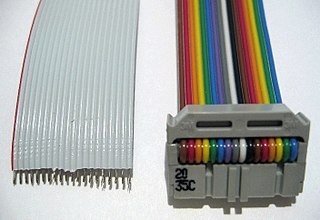
A ribbon cable is a cable with many conducting wires running parallel to each other on the same flat plane. As a result, the cable is wide and flat. Its name comes from its resemblance to a piece of ribbon.
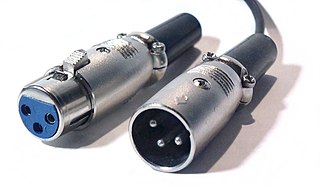
The XLR connector is a type of electrical connector primarily used in professional audio, video, and stage lighting equipment. XLR connectors are cylindrical, with three to seven connector pins, and are often employed for analog balanced audio interconnections, AES3 digital audio, portable intercom, DMX512 lighting control, and for low-voltage power supply. XLR connectors are part of the international standard for dimensions, IEC 61076-2-103. The XLR connector resembles the DIN connector, but is larger, more robust and physically incompatible.

A DC connector is an electrical connector that supplies direct current (DC) power.
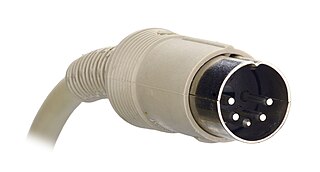
The DIN connector is an electrical connector that was standardized by the Deutsches Institut für Normung (DIN), the German Institute for Standards, in the mid 1950s, initially with 3 pins for mono, but when stereo connections and gear appeared in late 1950s, versions with 5 pins or more were launched. The male DIN connectors (plugs) feature a 13.2 mm diameter metal shield with a notch that limits the orientation in which plug and socket can mate. The range of DIN connectors, different only in the configuration of the pins, have been standardized as DIN 41524 / IEC/DIN EN 60130-9 ; DIN 45322 ; DIN 45329 / IEC/DIN EN 60130–9 ; and DIN 45326 / IEC/DIN EN 60130-9.

ATX is a motherboard and power supply configuration specification, patented by David Dent in 1995 at Intel, to improve on previous de facto standards like the AT design. It was the first major change in desktop computer enclosure, motherboard and power supply design in many years, improving standardization and interchangeability of parts. The specification defines the dimensions; the mounting points; the I/O panel; and the power and connector interfaces among a computer case, a motherboard, and a power supply.

The D-subminiature or D-sub is a common type of electrical connector. They are named for their characteristic D-shaped metal shield. When they were introduced, D-subs were among the smallest connectors used on computer systems.
Amphenol Corporation is an American producer of electronic and fiber optic connectors, cable and interconnect systems such as coaxial cables. Amphenol is a portmanteau from the corporation's original name, American Phenolic Corp.

A disk enclosure is a specialized casing designed to hold and power hard disk drives or solid state drives while providing a mechanism to allow them to communicate to one or more separate computers.
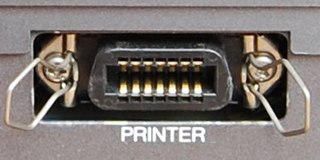
The micro ribbon or miniature ribbonconnector is a common type of electrical connector for a variety of applications, such as in computer and telecommunications equipment having many contacts.

An insulation-displacement contact (IDC), also known as insulation-piercing contact (IPC), is an electrical connector designed to be connected to the conductor(s) of an insulated cable by a connection process which forces a selectively sharpened blade or blades through the insulation, bypassing the need to strip the conductors of insulation before connecting. When properly made, the connector blade cold-welds to the conductor, making a theoretically reliable gas-tight connection.
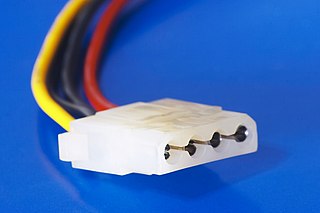
A Molex connector is a two-piece pin-and-socket interconnection which became an early electronic standard. Developed by Molex Connector Company in the late 1950s, the design features cylindrical spring-metal pins that fit into cylindrical spring-metal sockets, both held in a rectangular matrix in a nylon shell.
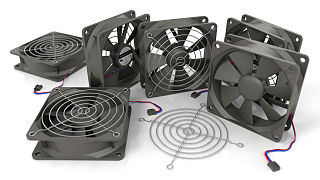
A computer fan is any fan inside, or attached to, a computer case used for active cooling. Fans are used to draw cooler air into the case from the outside, expel warm air from inside and move air across a heat sink to cool a particular component. Both axial and sometimes centrifugal (blower/squirrel-cage) fans are used in computers. Computer fans commonly come in standard sizes, such as 92 mm, 120 mm, 140 mm, and even 200–220 mm. Computer fans are powered and controlled using 3-pin or 4-pin fan connectors.

A power supply unit (PSU) converts mains AC to low-voltage regulated DC power for the internal components of a desktop computer. Modern personal computers universally use switched-mode power supplies. Some power supplies have a manual switch for selecting input voltage, while others automatically adapt to the main voltage.

Computer case screws are the hardware used to secure parts of a PC to the case. Although there are numerous manufacturers of computer cases, they have generally used three thread sizes. The Unified Thread Standard (UTS) originates from the United States, while the ISO metric screw thread is standardized worldwide. In turn, these thread standards define preferred size combinations that are based on generic units—some on the inch and others on the millimetre.

Socapex is a brand of electrical connectors, known in the entertainment industry primarily for their 19-pin electrical connectors, commonly known as Socapex connectors, and used in film, television, and stage lighting to terminate the ends of a multicable. They are wired with six hot/live pins, six neutral pins, six ground/earth pins, and a final central pin used to aid alignment of the male end of the connector with a female receptacle. The Socapex was first created by a company called Socapex in 1961, which later on became Amphenol Socapex. "Socapex" became a brand name owned by Amphenol Socapex, the term "Soca" is now often applied to similar off-brand connectors as a genericized trademark.

A pin header is a form of electrical connector. A male pin header consists of one or more rows of metal pins molded into a plastic base, often 2.54 mm (0.1 in) apart, though available in many spacings. Male pin headers are cost-effective due to their simplicity. The female counterparts are sometimes known as female headers, though there are numerous naming variations of male and female connectors. Historically, headers have sometimes been called "Berg connectors" or "DuPont" connectors, but headers are manufactured by many companies.

FASTON terminals or faston terminals are connectors that are widely used in electronic and electrical equipment. These terminals are manufactured by many companies, commonly using the terms "quick disconnect", "quick connect", "tab" terminals, "spade" terminals or blade connectors; without qualifiers, the first two could be mistaken for plumbing connections.

On June 26, 2007, Dell released the new Inspiron desktop series, under the Dell Inspiron branding, as a replacement to the Dell Dimension desktop computers.